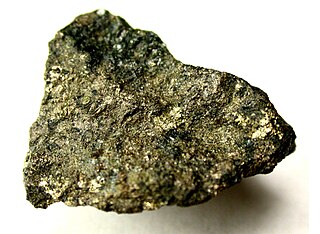
Pentlandite is an iron–nickel sulfide with the chemical formula (Fe,Ni)9S8. Pentlandite has a narrow variation range in nickel to iron ratios (Ni:Fe), but it is usually described as 1:1. In some cases, this ratio is skewed by the presence of pyrrhotite inclusions. It also contains minor cobalt, usually at low levels as a fraction of weight.
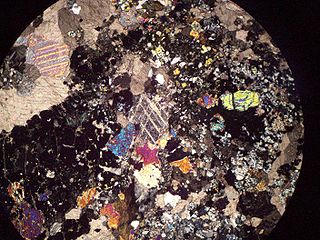
Skarns or tactites are coarse-grained metamorphic rocks that form by replacement of carbonate-bearing rocks during regional or contact metamorphism and metasomatism. Skarns may form by metamorphic recrystallization of impure carbonate protoliths, bimetasomatic reaction of different lithologies, and infiltration metasomatism by magmatic-hydrothermal fluids. Skarns tend to be rich in calcium-magnesium-iron-manganese-aluminium silicate minerals, which are also referred to as calc-silicate minerals. These minerals form as a result of alteration which occurs when hydrothermal fluids interact with a protolith of either igneous or sedimentary origin. In many cases, skarns are associated with the intrusion of a granitic pluton found in and around faults or shear zones that commonly intrude into a carbonate layer composed of either dolomite or limestone. Skarns can form by regional or contact metamorphism and therefore form in relatively high temperature environments. The hydrothermal fluids associated with the metasomatic processes can originate from a variety of sources; magmatic, metamorphic, meteoric, marine, or even a mix of these. The resulting skarn may consist of a variety of different minerals which are highly dependent on both the original composition of the hydrothermal fluid and the original composition of the protolith.

Pyrrhotite is an iron sulfide mineral with the formula Fe(1-x)S. It is a nonstoichiometric variant of FeS, the mineral known as troilite. Pyrrhotite is also called magnetic pyrite, because the color is similar to pyrite and it is weakly magnetic. The magnetism decreases as the iron content increases, and troilite is non-magnetic. Pyrrhotite is generally tabular and brassy/bronze in color with a metallic luster. The mineral occurs with mafic igneous rocks like norites, and may form from pyrite during metamorphic processes. Pyrrhotite is associated and mined with other sulfide minerals like pentlandite, pyrite, chalcopyrite, and magnetite, and has been found globally.

Vauxite is a phosphate mineral with the chemical formula Fe2+Al2(PO4)2(OH)2·6(H2O). It belongs to the laueite – paravauxite group, paravauxite subgroup, although Mindat puts it as a member of the vantasselite Al4(PO4)3(OH)3·9H2O group. There is no similarity in structure between vauxite and paravauxite Fe2+Al2(PO4)2(OH)2·8H2O or metavauxite Fe3+Al2(PO4)2(OH)2·8H2O, even though they are closely similar chemically and all minerals occur together as secondary minerals. Vauxite was named in 1922 for George Vaux Junior (1863–1927), an American attorney and mineral collector.
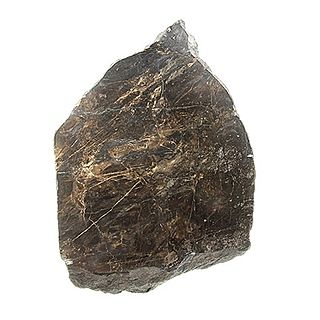
Galaxite, also known as 'mangan-spinel' is an isometric mineral belonging to the spinel group of oxides with the ideal chemical formula Mn2+Al2O4.
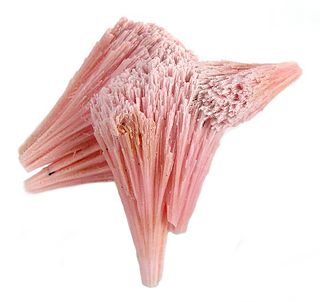
Kutnohorite is a rare calcium manganese carbonate mineral with magnesium and iron that is a member of the dolomite group. It forms a series with dolomite, and with ankerite. The end member formula is CaMn2+(CO3)2, but Mg2+ and Fe2+ commonly substitute for Mn2+, with the manganese content varying from 38% to 84%, so the formula Ca(Mn2+,Mg,Fe2+)(CO3)2 better represents the species. It was named by Professor Bukowsky in 1901 after the type locality of Kutná Hora, Bohemia, in the Czech Republic. It was originally spelt "kutnahorite" but "kutnohorite" is the current IMA-approved spelling.

Pabstite is a barium tin titanium silicate mineral that is found in contact metamorphosed limestone. It belongs to the benitoite group of minerals. The chemical formula of pabstite is Ba(Sn,Ti)Si3O9. It is found in Santa Cruz, California. The crystal system of the mineral is hexagonal.

Berlinite (aluminium phosphate, chemical formula AlPO4 or Al(PO4)) is a rare high-temperature hydrothermal or metasomatic phosphate mineral. It has the same crystal structure as quartz with a low temperature polytype isostructural with α–quartz and a high temperature polytype isostructural with β–quartz. Berlinite can vary from colorless to greyish or pale pink and has translucent crystals.

Canavesite, Mg2(HBO3)(CO3)∙5H2O, is a rare carboborate mineral from the abandoned Brosso mine in Italy. Canavesite is a secondary mineral that occurs due to the weathering of ludwigite-magnetite skarn on the surface of mine walls. The physical properties consist of milky-white rosette-like aggregates of elongated transparent fibers shown in figure one. It has the crystal symmetry of a monoclinic with a diffraction symbol of 2/mP-/-.

Coloradoite, also known as mercury telluride (HgTe), is a rare telluride ore associated with metallic deposit. Gold usually occurs within tellurides, such as coloradoite, as a high-finess native metal.

Stillwellite-(Ce) is a rare-earth boro-silicate mineral with chemical formula (Ce,La,Ca)BSiO5.

Sarabauite (sar-a-bau'-ite) is a red monoclinic sulfide mineral with the chemical formula: CaSb10O10S6.
Mooihoekite is a copper iron sulfide mineral with chemical formula of Cu9Fe9S16. The mineral was discovered in 1972 and received its name from its discovery area, the Mooihoek mine in Transvaal, South Africa.

Geerite is a copper sulfide mineral with the chemical formula Cu8S5. The mineral is named after the original collector, Adam Geer, of Utica, New York, US.

Fluor-uvite is a tourmaline mineral with the chemical formula CaMg3(Al5Mg)(Si6O18)(BO3)3(OH)3F. It is a rare mineral that is found in calcium rich contact metamorphic rocks with increased amounts of boron. Uvite is trigonal hexagonal, which means that it has three equal length axes at 120 degrees, all perpendicular to its fourth axis which has a different length. Uvite is part of the space group 3m. Uvite's hardness has been measured to be 7.5 on the Mohs hardness scale. The color of uvite widely varies, depending on the sample, but is mostly deep green or brown. In regard to uvite's optical properties, it is uniaxial (-) and anisotropic, meaning that the velocity of light in the mineral depends on the path that it takes. In plane polarized light, uvite is colorless to pale yellow and shows weak pleochroism.
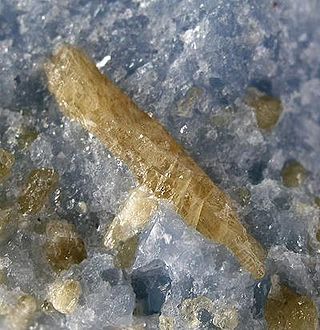
Fluorellestadite is a rare nesosilicate of calcium, with sulfate and fluorine, with the chemical formula Ca10(SiO4)3(SO4)3F2. It is a member of the apatite group, and forms a series with hydroxylellestadite.

Bultfonteinite, originally dutoitspanite, is a pink to colorless mineral with chemical formula Ca2SiO2(OH,F)4. It was discovered in 1903 or 1904 in the Bultfontein mine in South Africa, for which the mineral is named, and described in 1932.

Djerfisherite is an alkali copper–iron sulfide mineral and a member of the djerfisherite group.

Kosnarite is an alkali zirconium phosphate mineral (KZr2(PO4)3) named after an expert of pegmatites Richard A. Kosnar. Kosnarite contains potassium, oxygen, phosphorus, and zirconium with sodium, rubidium, hafnium, manganese and fluorine (Na, Rb, Hf, Mn, and F) being common impurities found in kosnarite. It was discovered in nature for the first time in 1991 by Vandall T. King. Samples that were found in granitic pegmatites from the Mount Mica Quarry, Paris, Oxford County, Maine, US were sent to Eugene E. Foord for study. This became the first recorded case of naturally occurring kosnarite.

Ganophyllite is a phyllosilicate mineral. It was named by Axel Hamberg in 1890 from the Greek words for leaf (φύλλον) and luster (γανωμα); the latter one was chosen due to the lustrous cleavages. The mineral was approved by the IMA in 1959, and it is a grandfathered mineral, meaning its name is still believed to refer to an existing species until this day. Tamaite is the calcium analogue, while eggletonite is the natrium analogue of said mineral.



















